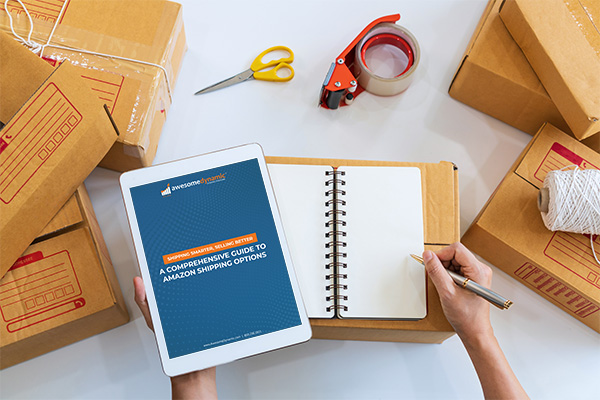August 13th, 2024
Amazon Fulfillment by Merchant or Seller Fulfilled Prime
For Amazon sellers, choosing the right shipping option is crucial for customer satisfaction and sales. Fast delivery and excellent customer service are key reasons why people shop on Amazon. They expect their orders to arrive quickly, which impacts their satisfaction, loyalty, and reviews.
While many sellers use Fulfillment by Amazon (FBA) to streamline their process, some prefer to handle fulfillment themselves. If you choose to manage your own orders, selecting the right Amazon shipping solutions is essential. How you store, prepare, and ship your products can set you apart from competitors and influence your brand reputation.
Amazon Fulfillment Options Comparison: Amazon FBM vs SFP
As an Amazon FBM seller, you can choose between two merchant-fulfilled options: standard Fulfillment by Merchant or Seller Fulfilled Prime. When comparing Amazon FBM and SFP, it’s important to understand how both of these programs work.
Fulfillment by Merchant (FBM) is a method where Amazon sellers handle the fulfillment of their orders. With FBM, sellers either manage shipping themselves or use a third-party logistics (3PL) provider.
Seller Fulfilled Prime lets you earn the coveted Amazon Prime badge if you meet their requirements. This option lets you ship directly to Prime customers from your own warehouse. By showing the Prime badge, you promise to deliver orders with Two-Day Delivery at no extra cost. Amazon helps you with the right transportation solutions to ensure you meet the high standards of the Prime customer experience.
Whether you’re starting out or optimizing Amazon shipping options to boost sales, understanding your options is crucial. The best shipping method for sellers depends on their specific business model and products.
Selecting a 3PL Provider for Amazon Fulfillment
When choosing between Amazon fulfillment options, consider partnering with a third-party logistics (3PL) provider. 3PL providers handle warehousing, fulfillment, and shipping for your business, offering a streamlined way to manage your inventory and orders.
Why Consider a 3PL Provider?
- Cost-Effective Solutions: 3PL providers can often offer more competitive shipping rates and save you money on warehousing and logistics compared to handling everything in-house.
- Scalability: As your business grows, a 3PL provider can scale with you, handling increasing order volumes and complex logistics.
- Expertise: Experienced 3PL providers have the technology and infrastructure to efficiently manage inventory, order processing, and shipping.
By partnering with a 3PL provider like Ware2Go, you can leverage their expertise and resources to optimize your Amazon shipping strategy, improve delivery times, and enhance customer satisfaction. This can be particularly beneficial if you choose FBM, as it allows you to maintain control over fulfillment while taking advantage of a 3PL’s efficiency and capabilities.
Ware2Go is a UPS-owned warehousing and fulfillment company that enables brands of all sizes to meet the delivery expectations of today’s consumers with a nationwide 3PL network, industry-leading service levels, and simple technology integrations.
Seller Fulfilled Prime Advantages for Businesses
Seller Fulfilled Prime launched in 2015 and quickly became popular. This option lets sellers add the Amazon Prime badge to their listings by committing to deliver products to Prime customers with the same fast and free shipping as regular Prime. It’s a great choice for sellers who want more control over order fulfillment and customer service.
While Seller Fulfilled Prime eligibility can be difficult to get, there are many Seller Fulfilled Prime (SFP) advantages. Sellers with the Prime badge often see higher profits compared to those without it. SFP can be more cost-effective than Fulfillment by Amazon (FBA) over time. It also provides greater control over inventory, fulfillment, and shipping, while still allowing you to benefit from Amazon’s customer service.
Key Differences Between Seller Fulfilled Prime (SFP) and Fulfillment by Amazon (FBA)
SFP Shipping Requirements & Benefits
- Store your stock in your own warehouse or with a third-party provider.
- Choose your own shipping carriers, potentially securing lower rates.
- Sell items that aren’t eligible for FBA while still using the Prime badge.
- Avoid high FBA storage fees and penalties for excess inventory.
Fulfillment by Amazon Shipping Requirements & Benefits
- Prep and ship your products to Amazon's fulfillment center(s) instead of sending them directly to customers.
- Your inventory will be listed with the Prime logo.
- Amazon takes care of packing, delivery, customer service, and returns.
- Pay for storage and fulfillment based on usage; no upfront fees.
- Shipping costs are included in the FBA fees.
Will Going the FBM Route Impact My Buy Box Eligibility?
Listing your products with Seller Fulfilled Prime boosts your chances of winning the Buy Box. Winning the Buy Box means that when customers click "Add to Cart," they automatically choose to buy from you. Since the Buy Box drives around 83% of all sales, having a better chance to win it is crucial for your success. Using SFP can give you a competitive edge if you use it effectively.
The Pros and Cons of Amazon FBM
Amazon FBM isn't ideal for every seller or product, but it can be a smart choice in certain situations. Fulfillment by Merchant (FBM) benefits sellers with unique items with little competition, products that sell slowly or in small quantities, and those with lower profit margins. By choosing FBM, you can save on costly FBA storage fees and penalties, especially for products with low turnover.
Maximizing profits with Amazon FBM:
FBM can be cheaper if you find a shipping partner offering lower rates than FBA, which charges based on weight and size. Additionally, FBM helps you avoid the frequent changes in pricing and policies that FBA sellers often face.
When FBM is the Best Choice:
- Your product is exclusive, with low demand and slow sales.
- Your item has low profit margins.
- Your shipping costs with FBM are lower than Amazon FBA rates.
When FBA is More Suitable:
- Your product has a high turnover rate and sells in large volumes.
- You are okay with lowering the cost to maximize your sales.
SFP vs FBM Shipping Costs
One of the biggest perks of choosing an FBM shipping strategy is its low initial cost, making it easier for your business to start without financial stress. With FBM, you mainly pay for shipping your orders, so there are fewer upfront expenses. However, costs can vary widely depending on your product range and the shipping options you select.
In addition to shipping costs, there are a few fixed fees with an FBM account. You can start with the free Individual Selling Plan or upgrade to the Pro plan for $39.99 per month. The Pro plan offers valuable features like A+ Content and detailed metrics not available with the free plan.
Amazon also charges a referral fee for each sale, which is a percentage of the total sales price. This fee is generally around 15% for most categories but can range from 6% to as high as 45% for some categories, like Amazon Device Accessories.
Is FBA Cheaper Than FBM?
When choosing how to ship ecommerce orders, cost is a key factor. Amazon FBA charges a fee of 10-20% on each transaction, and while these fees can vary depending on the product, they are an important factor to consider when choosing between FBA and FBM. For small businesses, FBM can be a more budget-friendly option, especially when starting out. With FBM, you have control over packaging and shipping but keep in mind that you’ll also need to spend more time on customer service.
How to Qualify for Amazon Seller Fulfilled Prime:
- Offer your customers premium shipping options
- Maintain a 99% on-time shipping rate by shipping at least 99% of your orders within the designated time frame
- Maintain an order cancellation rate of less than 0.5%
- Use Amazon Buy Shipping Services for at least 99% of orders
- Deliver your orders with Amazon-supported Seller Fulfilled Prime carriers
- Agree to the Amazon Returns Policy
- Allow for all customer service inquiries to be dealt with by Amazon
Can You Use Both FBM and FBA at the Same Time?
Can’t choose between Amazon FBM and Amazon FBA? Do both! Many sellers use FBA for their top-selling products and FBM for items that sell slowly or are seasonal. By combining both options, you can maximize your profits and avoid expensive inventory fees for products that linger too long in Amazon’s warehouses.
Choosing the right shipping method is a key part of your business plan. We can help you explore your options and find the best solution for your products. By offering actionable strategies and tips for successful Amazon FBM, FBA, or SFP selling, we’ll streamline your processes and boost your sales. Just follow this link and fill out the form. We'll email you to set up a time to discuss your needs.

